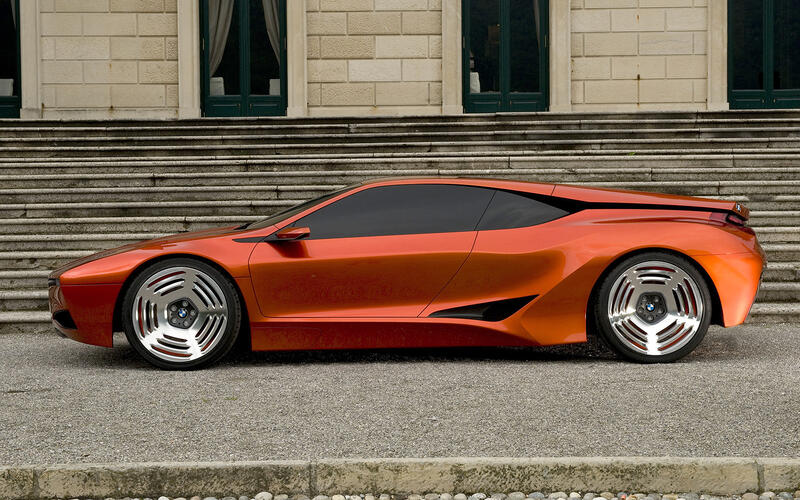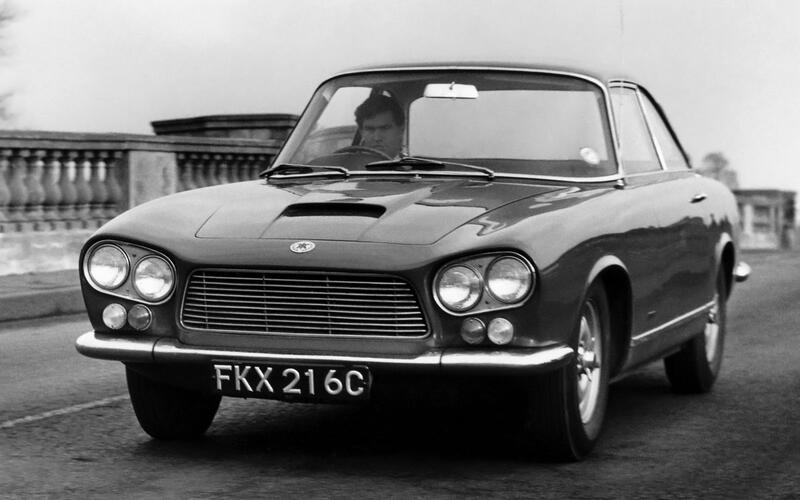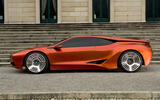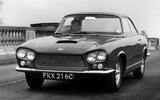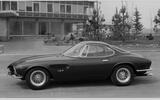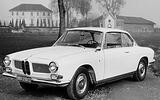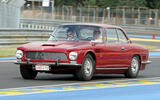 Slide of
Slide of
He's been called the most influential car designer of all time
Giorgetto Giugiaro entered his work into a student exhibition in 1955, where it was spotted by Fiat's technical director Dante Giacosa; the rest as they say is history. Let's see all the amazing designs he's come up with over the past few decades; some are stand-out rare, and some are common; and you might even drive one of his cars yourself:
Slideshow story - click right-hand arrow above to continue
 Slide of
Slide of
Gordon-Keeble GT (1960)
This is where it all started; with a British car that’s pretty much unknown thanks to just 100 examples having been built between 1964 and 1967.
Powered by a 5.4-litre Corvette V8, the Gordon Keeble featured a glassfibre bodyshell on a steel chassis. Virtually all of the cars built survive, thanks to an enthusiastic owners’ club.
 Slide of
Slide of
Ferrari 250 GT SWB Bertone (1960)
Six years after Ferrari first opened its doors for business it launched the 250, so named because each of the 3.0-litre V12's cylinders displaced 250c.
There was a huge array of variations on the 250 theme but one of the most sought after is the 250GT SWB, so called because its wheelbase was shortened by 200mm to improve agility and cut weight. Created primarily as a racer, some road-going cars were also built.
 Slide of
Slide of
BMW 3200 CS (1961)
The first BMW to feature the brand's famous Hofmeister Kink, named after the company's then head of design Wilhelm Hofmeister, it was actually Giugiaro who adopted the design feature on behalf of BMW, while he was working for Bertone.
He wasn't the first to use it though as Lancia had used it several years before.
 Slide of
Slide of
Iso Rivolta IR 300 (1961)
It's hardly what you could call a looker but the intriguing Rivolta was one of the most capable GTs of the 1960s. Powered by a 5340cc Corvette V8, just like the Gordon Keeble, the Rivolta was designed by Giugiaro when he was working for the Bertone design studio - with which he would later be in competition.
 Slide of
Slide of
Aston Martin DB4 GT Bertone 'Jet' (1961)
You'd be hard-pressed to argue that the Aston Martin DB4 GT was in need of visual improvement but Bertone gave it a go, with Giugiaro getting the gig.
Incredibly, despite being a one-off the Jet was bodied in steel so it weighs more than the donor car - which wasn't ideal considering it was created for the race track.
 Slide of
Slide of
ASA 1000 GT (1962)
Enzo Ferrari toyed with the idea of creating a small sports car in the early 1960s and the ASA 1000 GT was the result.
Powered by a 1.0-litre four-cylinder engine that was effectively a third of a 3.0-litre Ferrari V12, the ASA's chassis also borrowed design elements from the 250 GTO. But Ferrari decided to stick with his full-fat supercars and instead the project was made independently.
 Slide of
Slide of
Simca 1000 Coupé (1962)
Giugiaro was still wearing his Bertone hat when he came up with this pretty little coupé that came initially with a 944cc engine but was upgraded to a 1204cc unit in 1967.
While the early cars topped out at just 87mph, the later ones could get all the way to 105mph.
 Slide of
Slide of
Alfa Romeo Giulia Sprint GT (1963)
In 1962 Alfa Romeo launched its rather boxy 105-Series Giulia saloon and it was Giugiaro's job to sex things up a bit with a two-door edition.
That arrived in 1963 in the form of the Giulia Sprint GT with a 1570cc all-alloy twin-cam engine. Later would come 1.3-, 1.8- and 2.0-litre engines, the latter two in the Sprint GTV, also penned by Giugiaro.
 Slide of
Slide of
Mazda Familia (1963)
You can't accuse Giugiaro of slacking when he was at Bertone - they certainly got their money's worth.
Having launched with its first (kei) car in 1960, Mazda moved upmarket three years later with this small family saloon and estate with four-cylinder engines between 782cc and 987cc.
 Slide of
Slide of
Iso Grifo (1963)
There's been no shortage of European supercars and grand tourers over the years, built with the help of American motive power - and the Iso Grifo is one of the most enigmatic of the lot.
Powered by Chevrolet or Ford V8s, early Grifos got a 5.4-litre unit but from 1970 a mighty 7.5-litre unit was fitted, rated at 395bhp.
 Slide of
Slide of
Alfa Romeo Canguro (1964)
When Alfa Romeo wanted to build a low-volume TZ-based sports car in the 1960s it gave both Pininfarina and Bertone a TZ chassis and told them to come up with something; the Canguro was Bertone's creation, penned by Giugiaro.
Powered by a 1.6-litre four-cylinder engine the car looked gorgeous but Alfa got cold feet and never put either proposal into production.
 Slide of
Slide of
Innocenti 186 GT (1964)
This stillborn sports car was the result of a collaboration between Innocenti and Ferrari. The plan was to build a compact 2+2 coupé with a 1.8-litre V6 mounted in the nose and driving the rear wheels.
The car was developed and pretty much ready for production when everything went belly up, leaving just two cars made - one of which survives.
 Slide of
Slide of
Fiat 850 Spider (1965)
The Fiat 850 was one of the most popular small family cars in Italy during the second half of the 1960s, but most were saloons.
Some were coupés while others were seven-seat people carriers (yes, really!) - and there was this, a neatly designed convertible officially designed by Bertone but actually styled by Giugiaro.
 Slide of
Slide of
Mazda Luce (1966)
Throughout the 1960s Mazda continued its quest to move upmarket, with the Luce arriving in 1966. Initially available only with a 1.5-litre engine, by the end of 1968 there was also a 1.8-litre option.
Within a year there would also be a rotary-powered Luce - the only Wankel-powered Mazda to feature front-wheel drive.
 Slide of
Slide of
De Tomaso Mangusta (1966)
Designed by Giugiaro when he was working for the Italian styling house Ghia (later bought by Ford), the Mangusta was the predecessor to the far more high-profile Pantera.
As with that later car the Mangusta featured a Ford V8 which provided a top speed of somewhere around 160mph.
 Slide of
Slide of
Maserati Ghibli (1966)
Maserati has produced three different Ghiblis over the past half-century or so but this one is the original and by far the most beautiful.
Named after a hot, dry wind in the Libyan desert, the Ghibli was another car designed by Giugiaro when he was working for Ghia. In the nose was a 4.7-litre V8, later increased to 4.9 litres.
 Slide of
Slide of
Fiat Dino Coupé (1967)
Whereas Pininfarina was responsible for designing the Fiat Dino Spider, the Dino coupé was penned by Bertone - and specifically Giugiaro when he was an employee.
Powered by the same 2.0-litre (later 2.4-litre) V6 as the Ferrari Dino, the identically named Fiat has become hugely collectible in recent years.
 Slide of
Slide of
Isuzu 117 Coupé (1968)
Launched in the late 1960s, the Isuzu 117 survived right the way through to the early 1980s, albeit with a significant facelift in 1977.
Front-engined and rear-wheel drive, the 117 came with 1.6-, 1.8- or 2.0-litre petrol engines - or a 2.2-litre diesel.
 Slide of
Slide of
BMW Spicup concept car (1969)
Blending the characteristics of a spider and coupé (hence SpiCup), this BMW 2500-based concept was first seen on the Bertone stand at the 1969 Geneva motor show.
Sold off then used as a daily driver, the Spicup languished in a barn for two decades before it was completely restored in 2011 and sold for €460,000.
 Slide of
Slide of
Lotus Esprit (1972)
One of the all-time landmark car designs, the original Esprit was made famous as a Bond car on two occasions; an S1 featured in The spy who loved me while in For your eyes only there was an Essex Esprit Turbo.
Always powered by four-cylinder engines, it wasn't until 1996 that a V8 Esprit was available, almost a decade after the car had been redesigned by Peter Stevens.
 Slide of
Slide of
Maserati Merak (1972)
A development of the V8-powered Maserati Bora that Giugiaro also designed, the Merak featured a mid-mounted V6 engine that displaced either 2.0 or 3.0 litres.
Competing with the Lamborghini Urraco and Ferrari 308GT4 (both of which arrived later), the Merak lasted right the way through until 1983, by which time almost 2000 examples had been made.
 Slide of
Slide of
Hyundai Pony (1975)
First shown at the Turin motor show in October 1974, by 1975 the Hyundai Pony was being made in quantity - it was Korea's first mass-produced car.
It was also the first Korean car to be sold in the UK, although it wouldn't arrive here until 1982. Power came from 1.2-, 1.4- or 1.6-litre petrol engines.
 Slide of
Slide of
Suzuki Cervo (1977)
The Suzuki Cervo, also sold as the SC100 or Whizzkid, was such a neat design that elements of it were borrowed for the new Ignis that launched in 2016.
Created to comply with Japan's kei car regulations, the Cervo came with engines ranging from 539cc to 970cc.
 Slide of
Slide of
Zastava Yugo (1977)
Universally pilloried and poorly made, the Zastava Yugo wasn't a high spot in the history of the car but there's no denying that it provided affordable transport for hundreds of thousands of people around the globe.
Sold across Europe and the US, the Yugo carried an array of monikers including the Koral, Ciao, Tempo and GV; by the time the final car was made after more than two decades, almost 800,000 had been built in hatchback and convertible forms.
 Slide of
Slide of
FSO Polonez (1978)
In production for the thick end of two decades, the FSO Polonez grew out of a Fiat safety car project from 1970, although production didn't start until 1978.
Poverty-spec models got a 1.3-litre petrol engine but power junkies could buy a 2.0-litre petrol engine, while there were also a couple of diesel engines offered.
 Slide of
Slide of
Lancia Delta (1979)
It's easy to forget that the Integrale was actually sired by a more prosaic hatch that has now largely disappeared. Winner of the 1980 European Car of the Year, the Delta later became available as the Saab 600 in a joint venture between Lancia and Saab; few were made and they’re now even rarer than the Lancia-badged Delta.
 Slide of
Slide of
Volkswagen Jetta (1979)
While the first-generation Golf sold like hot cakes, in most markets buyers weren't so keen on the Jetta thanks to its reduced practicality.
Effectively a booted Golf, the Jetta came with the same engine choices as its sibling which meant petrol engines from 1.1 to 1.8 litres and - unusually for the time - the option of a diesel engine as well.
 Slide of
Slide of
Maserati Quattroporte III (1979)
The original Quattroporte was designed by Pietro Frua while Marcello Gandini penned the ultra-rare Quattroporte II. For the third iteration Giugiaro was asked to come up with something; this boxy saloon was the result.
Not one of his finest designs, all Quattroporte IIIs had a V8 engine; production lasted from 1979 until 1990.
 Slide of
Slide of
Fiat Panda (1980)
Created in the same mould as the Citroen 2CV, the Fiat Panda was a no-frills economy car that was offered with the 652cc air-cooled two-cylinder engine taken from the Fiat 126.
More popular though was the 903cc water-cooled four-pot. These early Pandas have become very collectible, especially in 4x4 form - they're capable of tackling astonishingly tough terrain.
 Slide of
Slide of
Fiat Uno (1983)
With almost nine million examples made over more than two decades, the Uno is one of the biggest-selling cars ever created. Launched by Fiat in 1983, the Uno was also made in North and South Africa, South America and Asia, with a huge array of different petrol and diesel engines fitted.
 Slide of
Slide of
Lancia Thema (1984)
Now largely forgotten, the Lancia Thema was the original Type 4 car, alongside the Saab 9000, Alfa Romeo 164 and Fiat Croma.
Of the four cars in the project, only one wasn't designed by Giugiaro; the Alfa Romeo was penned by Pininfarina which also came up with a design for the Thema estate. Most Themas were nice enough if not especially interesting - until the 8.32 arrived with a 3.0-litre V8.
 Slide of
Slide of
Saab 9000 (1984)
For Saab's most luxurious car yet, Giugiaro teamed up with the Swedish company's Bjorn Unvall to create a rather neat saloon and hatchback - but there wouldn't be an estate version.
Although the 9000 was supposed to share many of its parts with the other Type 4 cars, in reality virtually nothing was interchangeable thanks to Saab wanting its car to achieve much higher safety standards than its partners’.
 Slide of
Slide of
Seat Ibiza (1984)
SEAT built its first car in 1953 but it wouldn't be until 1984 that it produced its own model; until now they were all Fiat cast offs.
The Ibiza marked the start of a new chapter for SEAT with its Porsche-fettled engine (on some models) and an ultra-modern five-door hatchback design.
 Slide of
Slide of
Fiat Croma (1985)
Pretty much forgotten now, and laregly extinct, the Croma was Fiat's part in the Type 4 project.
Fiat's first large car to feature front-wheel drive and a transversely mounted engine, the Croma came with petrol or diesel power including - in the case of the former - V6 and turbocharged four-cylinder units giving up to 158bhp.
 Slide of
Slide of
Renault 19 (1988)
Here's a blast from the past, and one that's now pretty much disappeared altogether. Taking over where the Renault 9 and 11 left off, the 19 came in hatchback or convertible forms while saloon fans could buy the Chamade.
The latter is now especially rare, with less than a couple of dozen still in use on UK roads; there are fewer than 300 Renault 19s of all types still in use.
 Slide of
Slide of
Italdesign Aztec (1988)
One of the more left-field concepts, the Aztec went into limited production although just a handful were made. With no weather protection and separate cockpits for the driver and passenger, the Aztec was powered by a turbocharged five-cylinder Audi engine although bizarrely, the four-wheel drive transmission was taken from the Lancia Integrale.
 Slide of
Slide of
Seat Toledo (1991)
As with so many family cars of the early 1990s, the Seat Toledo wasn't exactly a high point in car design, but it was inoffensive enough.
On sale throughout the 1990s, this original Toledo was based on the Golf Mk2 which meant a choice of 1.6-, 1.8- or 2.0-litre petrol engines or there was a 1.9 diesel.
 Slide of
Slide of
Lexus GS (1993)
When Lexus came up with an executive car to take on the established premium brands, Giugiaro decided that a simplified design was the key, and that's exactly what he came up with.
Sold as the Toyota Aristo in its home market, the original Lexus GS came only with six- or eight-cylinder engines and four- or five-speed automatic transmissions.
 Slide of
Slide of
Seat Córdoba (1993)
The Cordoba has never been a big success for Seat in the UK, but it's sold better in European countries where small saloons are more popular.
Sharing the same platform as the Polo and Ibiza, buyers could choose between coupé, saloon and estate variations on the theme.
 Slide of
Slide of
Lamborghini Calà (1995)
Throughout the 1970s and 1980s Lamborghini offered junior supercars with V8 power; the Urraco, Silhouette and Jalpa.
By the 1990s it was V12 power all the way, but it could have been different as the fully driveable V10-engined Cala was unveiled in 1995. But the funds weren’t there to develop the car and the project was shelved.
 Slide of
Slide of
Volkswagen W12 (1997)
For a while VW seriously considered putting this W12-powered mid-engined supercar into production, but with the Veyron and various Lamborghinis to develop, plus the Audi R8, it didn't happen.
First came a 414bhp coupé followed by a roadster version of the same car. Then in 2001 came the most extreme W12 yet: a 591bhp Nardo edition which claimed an array of speed records, including covering 4809.8 miles in 24 hours at an average speed of 200.6mph.
 Slide of
Slide of
Daewoo Matiz (1997)
First seen as the Fiat Cinquecento-based Lucciola design study, the Daewoo Matiz may not have been exciting but it was a neatly styled city car created to provide minimalist transport.
Engines ranged from 0.8 to 1.2 litres with the car wearing a diverse array of badges including Chevrolet, Pontiac and FSO.
 Slide of
Slide of
Seat León (1998)
Even now, 20 years after it was unveiled, the original Seat Leon still looks modern and appealing. Offered only as a five-door hatch, the Leon Mk1 used the same PQ34 platform as the Golf Mk4, A3 and TT Mk1 along with the new Beetle and first-generation Skoda Octavia.
 Slide of
Slide of
Maserati 3200 GT (1998)
Most famous for its boomerang-shaped LED rear lights, the 3200 GT marked a welcome return of Giugiaro design to the Maserati brand.
After many years in the doldrums, Maserati desperately needed the 3200 GT to revive its fortunes, which it did reasonably well; almost 5000 were made in a four-year production run. Each was powered by a twin-turbo 3.2-litre V8.
 Slide of
Slide of
Alessandro Volta (2004)
Only ever intended to be a concept, the Alessandro Volta was named after the Italian Physicist who invented the battery. The name alluded to the car's motive power; a petrol/electric hybrid powertrain borrowed from the Lexus RX400h which combined a 3.3-litre V6 with two electric motors.
With 402bhp on tap, the drive-by-wire carbonfibre-bodied concept could top 155mph and do 0-62mph in just four seconds.
 Slide of
Slide of
Alfa Romeo 159 (2004)
Working in conjunction with Alfa Romeo’s Centro Stile design studio, Giugiaro came up with something of a masterpiece with the 159, a car that looked so much sharper than most of its contemporaries.
Buyers could choose between saloon and estate configurations and while top dog was a 3.2 V6 edition, sadly there was no 159 GTA.
 Slide of
Slide of
Ferrari GG50 (2005)
There's a big clue in the name of this one; it was created to celebrate 50 years of Giorgetto Giugiaro designing cars. Based on a Ferrari 612 Scaglietti and first shown at the 2005 Tokyo motor show, the GG50 featured a 540bhp 5748cc V12, a hatchback along with a 2+2 seating configuration.
 Slide of
Slide of
Fiat Grande Punto (2005)
At a time when small cars were all looking like homogenous blobs, Fiat came up with this brilliantly styled supermini that looked like a miniaturised Maserati.
Still in production in India, the Grande Punto morphed into the Punto Evo in 2009 when it was given a facelift.
 Slide of
Slide of
M1 Homage Concept (2008)
BMW unveiled the mid-engined gull-wing Turbo concept in 1972; six years later the M1 arrived, using much the same design but with a naturally aspirated engine - for road cars at least.
Thirty years after the M1 appeared, BMW came up with this tribute to its first mid-engined production car. It wasn’t a runner though.
 Slide of
Slide of
Techrules Ren (2018)
Showing that he's still very much at the sharp end of car design, in 2018 Giugiaro's latest confection was unveiled, the Techrules Ren. This Chinese hypercar aims to be the world's first turbine-powered car.
When combined with a lithium-ion battery pack driving two, four or six electric motors there's anything up to 1287bhp available, along with 1725lb ft of torque - which makes the 199mph top speed and 0-62mph time of 2.5 seconds seem rather underwhelming.
Include in Apple News:

